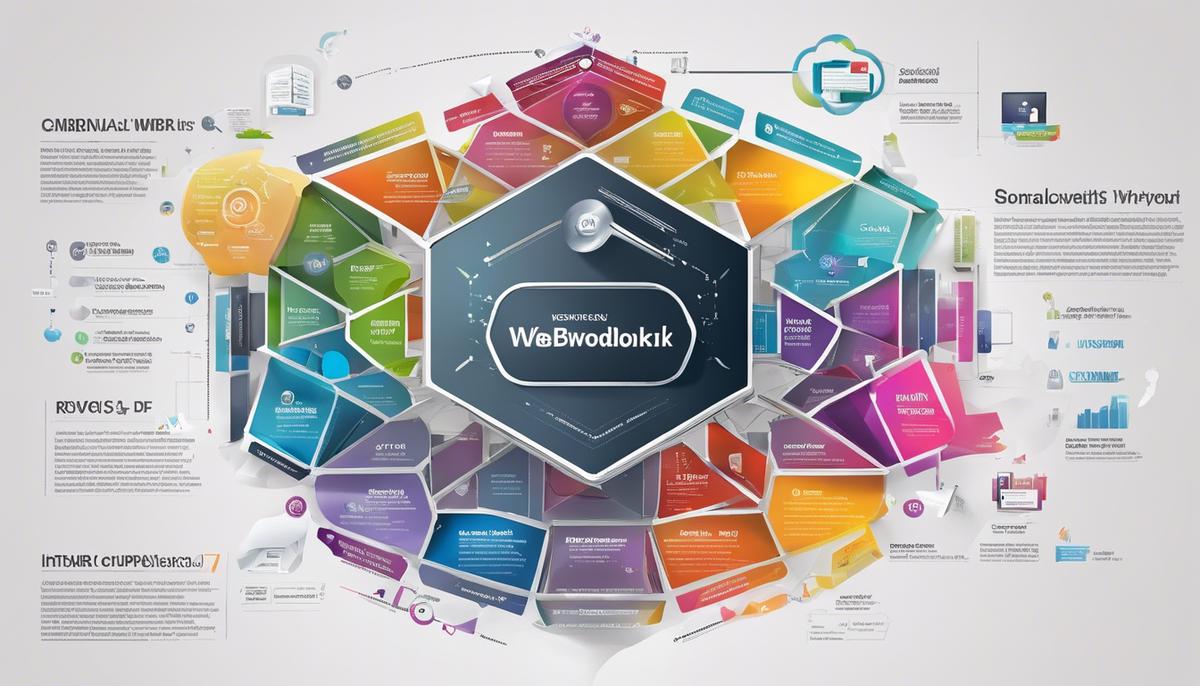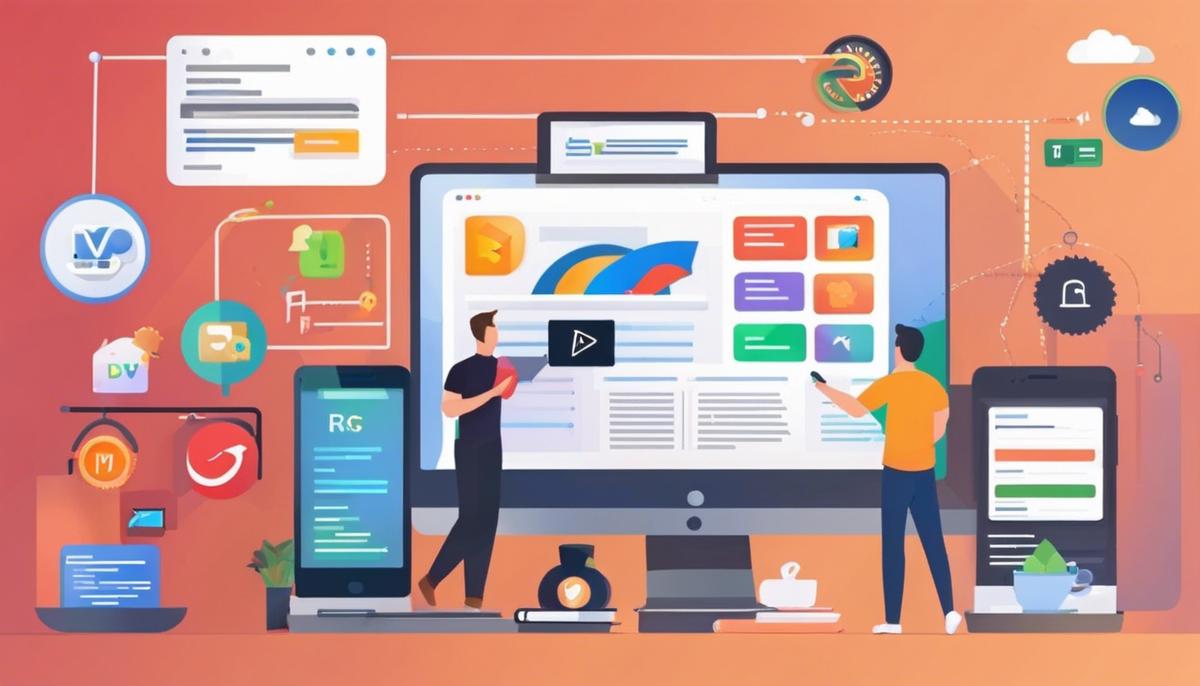In the ever-evolving landscape of technology, it’s paramount to be up-to-speed with the latest trends in web development. It’s not just about coding and programming. Today’s web development is a fusion of creativity, technical prowess, and an understanding of user experience. This article delves into some of the most significant trends shaping the industry including modern frameworks in web development, Progressive Web Apps (PWAs), API-first development, web development automation tools, and serverless architectures and microservices. These are the transformative trends and technologies that are reformulating the way websites are built and utilized.
Modern Frameworks in Web Development
Headline: The Game-Changing Impact of Modern Web Development Frameworks on Today’s Internet Landscape
The digitized era of the 21st century is nothing short of remarkable, especially when looking at the world of web development. The foundations of how the web is built and experienced are undergoing revolutionary changes, primarily attributable to modern web development frameworks. These frameworks form the linchpin of an ongoing paradigm shift, transforming the internet landscape for developers, entrepreneurs, and end-users alike.
Angular, React, Vue.js – these are no longer just fancy buzzwords. Instead, they have become crucial tools in the tech enthusiast’s arsenal. Aptly equipped, web developers around the globe are constructing websites and web applications more rapidly, efficiently, and intuitively than ever before.
Revamping Efficiency and Productivity
Without skirting around the facts, it’s clear cut – web development frameworks are boosting efficiency. They encapsulate a multitude of prewritten code for standard programming functions and tasks, accelerating the construction process. Veteran developers, freed from reinventing the wheel, can devote time to more critical, complex aspects of a project. Thanks to this newfound productivity, developers can bring innovative apps to market much faster.
Impacting User Interaction & Experience
These frameworks are not only sowing seeds in the developer’s garden but are radically shaping user interaction. Single Page Applications (SPAs), primarily built using JavaScript frameworks like Angular and React, load a single HTML page for user interaction. Consequently, user engagement soars owing to an enhanced and efficient browsing experience akin to a desktop application.
Moreover, the advent of Progressive Web Apps (PWAs), is blurring the line between web and native mobile experiences. Empowered by these frameworks, PWAs deliver a fast, reliable, and engaging mobile experience that can easily rival native mobile applications.
Boost to Customization and Flexibility
Modern web development frameworks have opened numerous doors for customization and flexibility. The modularity of these tools allows developers to pick only the required functions, creating lightweight applications tailored to specific needs.
Vue.js, for instance, known for its flexibility and ease-of-use, allows developers to build user interfaces from scratch or integrate into existing projects. This versatility brought by development frameworks precisely reflects the need for personalized experiences in today’s digital age.
Firebase and other Backend-as-a-Service platforms are becoming increasingly popular as they allow developers to focus on front-end development without worrying about server management and database operations. Integrating these services with modern frameworks simplifies the development process and further aids in rapid prototyping.
Conclusion: Modern Web Frameworks – The Future Is Now
Restating the obvious would be redundant – modern web development frameworks are no longer a prop, they have taken the center stage. They are remapping the global internet landscape, audaciously propelling us towards an era of web that’s faster, more user-friendly and more customizable. As they evolve and mature, our journey into a crisper, more immersive web experience is just beginning.

Progressive Web Apps (PWAs)
Some may ask, “What makes Progressive Web Apps (PWAs) a game-changing trend in the web development world?” This topic has garnered attention and become a major point of discussion among both frontend and backend developers. The answer to this trend’s increased acceptance lies in its added capabilities and advantages over traditional web applications.
Progressive Web Apps offer an immersive full-screen experience with help from a web app manifest file and can even re-engage users with web push notifications. The web app manifest is a simple JSON file that tells the browser about the web application and how it should behave when ‘installed’ on the user’s mobile device or desktop. It’s an elegant solution to an issue that once required complex workarounds.
Being built on the Service Workers’ technology, PWAs effectively deal with intermittent internet connectivity and ensure an offline user experience. This adaptability makes PWAs remarkably reliable, regardless of network conditions. A PWA can load instantaneously, eliminating dependence on a network request ensuring a seamless user experience.
One significant edge that Progressive Web Apps hold over native mobile applications is their responsiveness. They can adjust to any form factor, desktop, mobile, tablet, or forms yet to emerge. The ‘Progressive’ in PWAs means they’re designed to be that way from the outset as responsive design is one of their central pillars.
Yet another aspect that puts Progressive Web Apps in the spotlight is the low data usage compared to traditional mobile apps. In countries where internet speed and data usage is still a challenge, this feature alone might tip the scales in favor of PWAs.
Moreover, PWAs are making a strong case in terms of discoverability and easy updates. Thanks to the W3C manifest and service worker registration scope, allowing search engines to find them, PWAs can be easily indexed. Also, when it comes to updates, the process is far more straightforward and faster due to the service workers’ updating process.
In the realm of cyber threats, Progressive Web Apps have a fort up their sleeves – they’re served via HTTPS. This guarantees that the app can’t be tampered with or sabotaged during its delivery over the network. Let’s not forget the fact that this also enhances privacy and data integrity for both users and developers.
Lastly, the reduced need for app store submission and approval process is an added gain for businesses. Updating a PWA is as simple as refreshing a web page and the installation process involves just a few clicks—bypassing the need for lengthy downloads or complex installations.
As the technology landscape continues to evolve, the shift towards Progressive Web Apps seems inevitable. The benefits of PWAs—offline capabilities, device agnosticism, reduced data usage, easy updates, improved security topped with an app-like user experience—make them the torchbearers of future web development. This modern solution represents a substantial leap forward in the world of web development.

API-First Development
Unlocking the Future: Delving into API-First Development
Having looked at the momentous impact of advanced web development frameworks, it’s prudent to draw attention towards an emerging trend that’s changing the playbook of web development: API-first development. Capitalizing on this crucial strategy fosters exponential growth and enhances operational efficiency, assertedly making it central to an optimized web development process.
API-first development, as the name suggests, prioritizes building APIs before any other components. Instead of being an afterthought, APIs become the fundamental building blocks around which applications are built. Since APIs serve as the fundamental communication channel between application components, placing them at the forefront ensures a seamless, versatile, and inherently flexible architecture.
So why has this trend gained such momentum?
Firstly, an API-first approach promotes agility. In a climate besotted with rapid technological change and growing user expectations, this strategy allows for seamless integration of new features and unhindered scalability. Gone are the days when a slight modification would necessitate a massive overhaul of the entire application. API-first development ensures that applications are robust and adaptable, providing the necessary edge in a fiercely competitive market.
Next, enforcing API-first development simplifies the process of developing multiple client-facing applications. Instead of writing separate APIs for mobile, web, and desktop applications, developers can employ a singular, all-encompassing API. This unified strategy spurs synchronized workflow across platforms, leading to improved cross-platform consistency.
Additionally, API-first development strengthens development efficiency through parallelism. GUI developers and backend developers work persistently without waiting for each other, vastly improving development speed and efficiency. Time, after all, is a scarcity in the tech world.
Last but not least, shifting towards this trend bolsters long-term maintainability. A key aspect of technological advancement is to not become obsolete. API-first methodologies allow for APIs to be modified, developed, and updated, keeping stride with technological progress and market expectations. Leading to improved software longevity, it seems that the API-first approach is more of a necessity than a choice.
A boundless tech landscape awash with incessant innovation hinges on the adoption of this efficient, agile, and forward-looking approach. Acknowledging the high stakes of the digital age, it becomes clear that API-first development isn’t merely a passing trend. Instead, it serves as the backbone of future-ready applications, fueling a new era of web development.
From the above, it’s evident that evolution in technology doesn’t merely revolve around who invents first but also who adopts and adapts efficiently. API-first development, therefore, rightfully holds the reins in identifying future technologies, making it unabashedly crucial and relentlessly relevant in contemporary as well as future web development scenarios. Indeed, the future of the digital sphere is exciting, open-ended, and holds infinite possibilities.

Web Development Automation Tools

Serverless Architectures and Microservices
After understanding the significance of modern web development frameworks, PWAs, and API-first development, you must be gazing into the future, curious about the next big thing in web development. Well, the future is here and its name is serverless architectures and microservices. So, why are these becoming the new norm in web development?
Serverless architectures aren’t, despite the somewhat paradoxical name, systems without servers. They do involve servers, but developers do not need to manage, provision, or maintain these servers. Instead, cloud providers handle the infrastructure, allowing developers to focus solely on writing and deploying code. Such a shift is freeing up a significant portion of resources and opening up an entirely new dimension of productivity and efficiency.
A core component of serverless architecture is FaaS (Function as a Service). Described in layman’s terms as “functions as a service”, FaaS offers a platform that enables developers to execute portions of application functionality — the “functions” — in response to events. The ability to execute code without considering server system concerns yields an exponential increase in efficiency and speed.
While serverless architectures revolutionize the management and execution of applications, microservices shake up the structure of the application itself. Traditional monolithic architectures, where the application is one indivisible unit, are giving way to microservices. These divide the application into a collection of loosely coupled services, each of which corresponds to a business operation.
This modular architecture grants an unmatched level of flexibility. Modification or extension of functionalities no longer requires redevelopment or redeployment of the entire system. Instead, developers can focus on smaller, more manageable pieces. This both reduces the risk of sweeping system failure and speeds up the development process, allowing for quicker release and deployment cycles.
Moreover, microservices enable each service in an application to be deployed, run, and scaled independently. This allows for far superior scalability than in monolithic applications. As a result, applications built with microservices can support an expansive and variable user base.
Combining serverless architectures with microservices creates an approach that is efficient, scalable, and resilient. This merger simplifies deployment, improves scalability, ensures rapid development, and provides cost-effective solutions. You pay only for the compute power you use, and since the servers are managed by the cloud provider, operational costs are significantly lessened. In this way, businesses can develop products rapidly without being burdened with managing and maintaining hardware.
The rising acceptance of such architectures signals a shift towards a practical and efficient way of developing web applications that can meet the ever-evolving and complex demands of users. As these approaches become commonplace, developers will redefine the constraints and possibilities within the world of web development, revolutionizing how we interact with the internet.
With the advent of serverless architectures and microservices, one thing is clear: the future of the digital landscape is becoming more sophisticated, efficient, and streamlined. With these new concepts and technologies, web development is poised to reach new heights.
Welcome to the new normal.

The breathtaking pace at which web development continues to evolve illuminates the endless possibilities that await in the future. The current trends, from modern frameworks to PWAs, API-first development to web development automation tools, and serverless architectures and microservices, are the game-changers. They are instrumental in shaping the realm of web development by making it more efficient, versatile, and user-centric. As these trends continue to gain traction, they’re setting the precedent for the next generation of innovative web applications and making the web a more interactive and engaging place for everyone.
